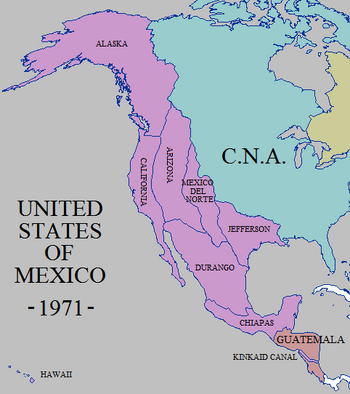
The United States of Mexico, or U.S.M., is a nation that occupies the western and southern areas of the North American continent. It was founded in 1820 out of a merger of the Republic of Mexico and the State of Jefferson. Its capital and largest city is Mexico City, and its currency is the Dolar ($).
The Mexico City Convention[]
From its foundation on 17 March 1805, the Republic of Mexico was divided between the Federalists, who wanted a secular state, and the Clericalists, who wanted the Catholic Church to be the republic’s state religion. Fighting broke out between the two factions on 14 April 1806, but for the most part the Mexican Civil War was a war of ambush and reprisal, as the Federalists maintained control of the government in Mexico City. When the Federalists began carrying out large-scale reprisals in 1815, the leaders of the State of Jefferson decided to intervene.
In July 1816, a Jeffersonian army under Colonel Andrew Jackson crossed the Rio Grande into Mexico. The Jeffersonians allied themselves with the Clericalists, and on 6 February 1817, the combined armies occupied Mexico City. The Clericalists began to carry out mass executions of Federalists, prompting Jackson to seize control of the government in June 1817 and proclaim himself Mexico’s provisional president. Jackson followed this by winning election as one of the three Governors of the State of Jefferson in October 1818, along with his allies James Monroe and Josephus Carter. Jackson then arranged for a constitutional convention to be held in Mexico City in September 1820, attended by delegates from both Mexico and Jefferson. The Constitution drafted by the Mexico City Convention established a unified nation known as the United States of Mexico.
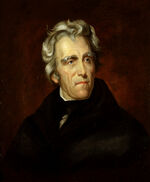
Andrew Jackson.
Under the new constitution, the U.S.M. was divided into six states: Jefferson, Mexico del Norte, Arizona, California, Durango, and Chiapas. The government consisted of a popularly elected Assembly of a hundred members with a tightly restricted franchise, a Senate of twenty-four members selected by the states, a President chosen by the Senate for a six-year term, and a national court called the Mexico Tribunal whose members were nominated by the President and ratified by the Senate.
One year after the delegates to the Mexico City Convention ratified the new constitution, the U.S.M.’s first national elections were held. Jackson’s allies, known as the Continentalist Party, dominated the newly-established United States Senate, which chose Jackson as the U.S.M.’s first President. Jackson’s opponents joined together to form the Liberty Party.
The Jackson Era and the Rocky Mountain War[]
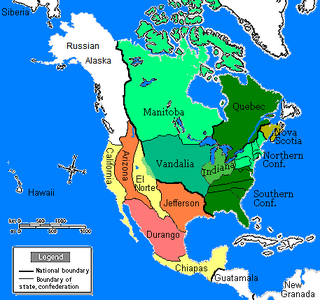
The U.S.M. on the eve of war, 1845.
Andrew Jackson did his best to form the new nation's disparate peoples into a cohesive whole during his three terms as President. He relied on allies among the U.S.M.’s Indian and Hispano populations to help him rule the country. He aligned the U.S.M. with France, and was able to stabilize the country's finances after gold was discovered in California in 1838. Jackson was finally succeeded as President in 1839 by Liberty Party candidate Miguel Huddleston, a Hispanicized Jeffersonian, and Huddleston was succeeded six years later by another Continentalist, a native Hispano from Jefferson named Pedro Hermión. Shortly after Hermión's inauguration in 1845, a conflict between Mexican and North American settlers broke out in the Rocky Mountains, leading to war between the U.S.M. and the Confederation of North America.
Although Sobel describes Hermión as aggressive and bellicose, the strategy he followed in the war was a purely defensive one. All the action in the war consisted of North American incursions into Mexican territory. For eight years, the Mexicans successfully fended off North American attacks, first under President Hermión, and then under his successors, Raphael Blaine and Hector Niles.
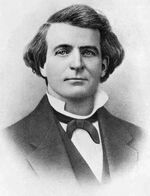
Hector Niles.
By 1853, the people of the C.N.A. had grown weary of the war, and in the 1853 Grand Council elections, the ruling Liberal Party lost control to the anti-war Conservative Party. The leader of the new Conservative majority, Councilman William Johnson of Manitoba, took power as Governor-General on February 16.
Johnson and Niles agreed to a battlefield truce in August while teams of negotiators from both nations met in The Hague. An arbitration panel consisting of representatives from the Germanic Confederation, the Netherlands and Spain began meeting in November, and issued a final report on 15 June 1855. The report recommended that the U.S.M. cede a small portion of Mexico del Norte to the C.N.A., and that the C.N.A. pay the U.S.M. N.A. £2,500,000 in indemnities. The two nations accepted the panel's findings, and a formal peace treaty was signed on 7 August 1855.
The Rise of Kramer Associates[]
In the U.S.M. relief at the end of the Rocky Mountain War gradually gave way to dissatisfaction with the outcome. President Hector Niles’ Liberty Party was denounced by the rival Continentalist Party for its “betrayal of the memory of Pedro Hermión”. In the 1857 Mexican elections Niles was defeated by Arizona’s Continentalist Governor Arthur Conroy. Following his re-election in 1863, Conroy proposed amending the Mexican Constitution to allow direct election of Senators and the President, and the extension of the franchise to all free Mexicans. Although Conroy’s proposals were opposed by some of his fellow Continentalists, he was able to gain passage of them with help from the Libertarians.
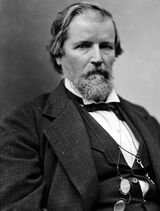
Bernard Kramer.
Meanwhile, in San Francisco, a wealthy businessman named Bernard Kramer formed a consortium called Kramer Associates in 1865 to build a canal linking the Atlantic and Pacific Oceans. After considering canals through Chiapas and Panama, Kramer decided to build the canal through the Central American republic of Guatemala. Opposed to Conroy's reforms, at the 1869 Continentalist Party caucus, Kramer arranged for his own Senator, Omar Kinkaid, to receive the presidential nomination. Kinkaid won the election, and as President began negotiations with Guatemala for rights to a canal. When word came that Guatemalan dictator Miguel Rubio had given the rights to a German consortium, Kramer arranged for Rubio to be overthrown on 9 March 1870. Guatemala's new Kramer-backed ruler signed over rights to a canal the following month, and work on the canal began quickly. The canal was finally completed in 1878, and was later named after Kinkaid.
The Hermión Dictatorship[]
Kinkaid was renominated by the Continentalists in 1875 and went on to win a second term as President. The Liberty Party suffered a split, as followers of Senator Carlos Concepción broke away to form the Workers' Coalition. Following the election, Concepción and his followers, calling themselves the Moralistas, began a guerrilla campaign to overthrow the government. Like Conroy before him, Kinkaid embraced a reform program, and overcame opposition within his own party by allying himself with the Libertarians. However, Kinkaid was killed in a bombing attack on 7 December 1879, and the Senate selected Senator George Vining of Jefferson to replace him. Vining blamed his predecessor's death on the Moralistas, and created a secret police force called the Constabulary to hunt them down. He appointed Pedro Hermión's son Benito Hermión to the post of Commandant of the Constabulary.
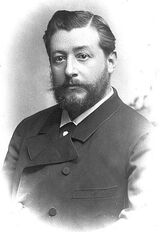
Benito Hermión.
In Europe, a war between France and the Germanic Confederation ended in a German victory. Rioters in Paris murdered the French royal family on 25 December 1879, and German troops occupied the French capital. The German soldiers mutinied, and marched back to Germany, spreading insurrection there. The insurrection spread to Austria and the Italian kingdoms, and from there to the rest of Europe. France became a battleground between republicans and monarchists. Millions of Europeans fled the chaos, settling in North and South America, Africa and Australia.
In the U.S.M., Constabulary agents raided the Workers' Coalition Party convention on 15 July 1881, killing 23 delegates and injuring 65. This sparked a general uprising across the country, prompting Vining to place the U.S.M. under martial law. Vining suffered a fatal heart attack on 12 September, and his Cabinet postponed the upcoming elections and appointed Benito Hermión to the position of "Chief of State". When leading members of the Liberty Party opposed the Cabinet's decisions, they were arrested or killed. Kramer's successor at K.A., Diego Cortez y Catalán, supported Hermión's dictatorship. Hermión denounced the French revolutionary government, confiscated the property of French nationals in Mexico, and in 1882 repudiated the U.S.M.'s debt to France. Hermión allied the U.S.M. with the Germanic Confederation in 1886, and within months invaded and conquered Guatemala. Four years later, Hermión also invaded and conquered the South American nation of New Granada, making his elder brother Victoriano Hermión its new President.
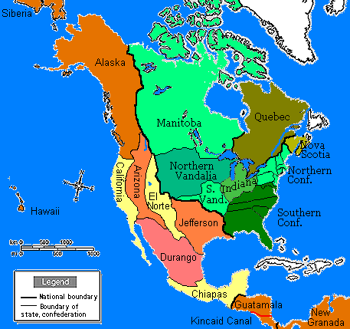
The U.S.M. in 1900.
Under the Hermión dictatorship, Cortez expanded K.A.'s operations beyond Mexico. He financed railroads in Manchuria and the Argentine, a copper mine in the Congo, and a steel mill in Belgium. When K.A.'s interests in the Hawaiian Islands were threatened by local rulers in 1892, Hermión obligingly conquered and annexed them. When K.A.'s gold mines in Russian Alaska were expropriated by the Russian government in 1897, war erupted between Russia and the U.S.M. the next year. By October 1898, the U.S.M. had conquered Alaska. Although Cortez was satisfied with this result, Hermión was not; in the summer of 1899, Mexican troops invaded Siberia and set up a puppet regime there. Within months, revolution broke out in St. Petersburg and the Russian monarchy was overthrown. Over the next five years, the Russian Empire disintegrated. Hermión, meanwhile, declared himself Emperor of Mexico on 2 April 1901.
Hermión's new Imperial pretensions provoked widespread resistance. People who had gone along with his regime as the only alternative to chaos, including Cortez, now found themselves fearing that the cure was worse than the disease. Throughout the summer of 1901 the opposition to Hermión grew, and a plot was hatched to overthrow him. Members of the K.A. security police infiltrated the recently-renamed Imperial Palace on 15 October and called for Hermión's capture. Hermión fled the palace disguised as a butler and made his way to Tampico, where he boarded ship for exile in Spain.
War and Manumission[]
Following Hermión's ouster, Kramer Guard Commandant Martin Cole, who controlled the Imperial Palace, proclaimed himself head of a provisional government and announced the restoration of the pre-Hermión Constitution. On 15 November Cole granted amnesty to all Mexican political exiles and announced that elections would be held the following June. Of the 14 Presidential candidates, none received more than 15% of the vote, and a runoff election was held between the top three candidates. An exiled Continentalist Senator from Durango, Anthony Flores, won the Presidency with a plurality of 45%. Flores' rule was uneventful, and he won re-election in 1908 as head of the new United Mexican Party.
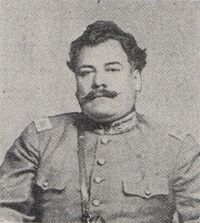
Emiliano Calles.
President Flores retired in 1914, and his chosen successor, Secretary of State Victoriano Consalus defeated the Libertarian candidate, Senator Albert Ullman of California. Within months of his election, Consalus faced a major challenge when the bellicose President of France, Henri Fanchon, declared war on the U.S.M., a conflict known as the Hundred Day War. French forces landed in Tampico on 28 June, and soon advanced on Mexico City. They were defeated by General Emiliano Calles at the Battle of Chapultepec on 28 August, and surrendered the next morning. Calles placed the French garrison at Tampico under siege, and it surrendered on 29 September. President Fanchon sued for peace on 3 October, and a truce was signed on 10 October.
The war brought lasting trouble for the U.S.M. when slaves liberated by French troops were arrested and tried for treason. The slaves' trials provoked international outrage, especially in the C.N.A., where Southern Vandalia Governor Howard Washburne called for the slaves to be released and for the abolition of slavery in the U.S.M. 34 members of the Grand Council announced their support for Washburne, who formed an organization called Friends of Black Mexico (F.B.M.) to press the issue. On 4 January 1916, the day before the verdict was to be announced on the imprisoned slaves, riots broke out in Mexico City, and a mob backed by the F.B.M. stormed the prison where the slaves were being held and freed them.
In the U.S.M., internal passports and curfews were established to prevent a feared general slave uprising, and growing violence was directed at abolitionists. The dilemma continued to hang fire until 1920, when General Calles ran for President as a Libertarian and defeated Consalus. Within weeks of his inauguration, Calles called for the abolition of slavery. Proslavery politicians, reluctant to cross the popular leader, agreed to passage of a manumission act by a voice vote. On 14 May the act passed, and was signed into law by Calles on the 21st, abolishing slavery in the U.S.M.
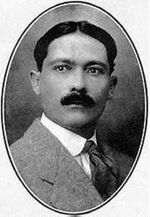
Pedro Fuentes.
Popular opposition to abolition continued, spearheaded by Assemblyman Pedro Fuentes of Chiapas. Violence was directed against the freedmen, and against antislavery politicians. Manumission Bureaus were burned down, and a mob formed in Mexico City on 22 September to prevent any slaves from being freed. President Calles himself, accompanied by a newly freed slave, faced down the mob, and the anti-manumission movement quickly died out.
President Calles followed his abolition of slavery by seeking in 1922 to regularize the status of the areas conquered by Benito Hermión. He proposed that Siberia, Alaska, Hawaii, Guatemala and New Granada should each hold plebiscites to choose whether they should gain statehood in the U.S.M. or seek full independence. The leaders of Siberia and New Granada rejected the idea, while the governments of the other three states accepted. In 1923 Alaska and Hawaii voted for statehood, while Guatemala voted for independence. Calles was unable to carry out any further reforms, and when he ran for re-election in 1926 he was defeated by Assemblyman Fuentes.
The Global War[]
Fuentes viewed the power wielded by Kramer Associates as a threat to the U.S.M., and he took steps to bring the company under control. John Jackson, who became President of K.A. in 1926, responded by throwing up legal obstacles. Beginning in 1929, Jackson began restructuring and decentralizing K.A., eventually moving the corporation's central offices from San Francisco to the Philippines in 1936. In the meantime, Fuentes ran for re-election in 1932, but was defeated by the Libertarian candidate, Senator Alvin Silva of Durango.
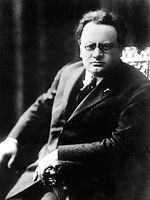
Alvin Silva.
President Silva increased the Mexican arms budget and signed an accord with the Germanic Confederation in 1934, prompting a similar alliance between Great Britain and France. K.A.'s move from San Francisco to the Philippines in 1936 caused a worldwide recession, defusing war tensions for a time, but within a year tensions were mounting again. November 1937 saw the re-election of the imperialistic Karl Bruning in the Germanic Confederation and the combative George Bolingbroke in Great Britain, while February 1938 saw the election of the isolationist Bruce Hogg as Governor-General of the C.N.A. and the re-election of Silva.
The Global War was finally sparked by an Arab uprising in the Ottoman Empire in August 1939, with the British supporting the Ottoman government and the Germans supporting the Arab rebels. War broke out between Britain and the Germanic Confederation in October, and lightning German offensives conquered France and the Ottoman Empire in the next two months. A year later, three German armies drove east from the Ottoman Empire and overran India by December 1941.
The U.S.M. attacked Japan in January 1942 and invaded China from Siberia. The Germans become bogged down in the Dutch East Indies while the Mexicans launched a naval attack across the Pacific. By 1944, the Mexicans and Siberians were being driven out of China and the Germans faced growing insurgencies in Europe. By the end of 1948 the Japanese had driven the Mexicans out of the western Pacific and overrun Siberia, while the Germans became involved in a series of wars among the Russian successor states.
The Postwar World[]
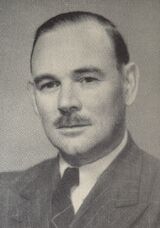
Vincent Mercator.
Silva was blamed for mishandling the war, and he lost the Presidential election of 1950 to Admiral Paul Suarez. The election was marred by political violence and electoral fraud, resulting in a military coup led by Colonel Vincent Mercator.
The detonation of an atomic bomb by Kramer Associates in June 1962 led to an international atomic arms race. The British detonated their own bomb in 1965, followed by the Germans and the C.N.A. in 1966. Attempts by the U.S.M. to build an atomic bomb remain unsuccessful as of November 1971.
Mercator, after eleven years as self-proclaimed President, arranged for the election of a hand-picked figurehead, Raphael Dominguez, in 1965, while maintaining control from behind the scenes as Secretary of War. The discovery of a Mexican spy ring in Michigan City led to a break in diplomatic relations between the U.S.M. and C.N.A. in 1969, and the outbreak of guerrilla activity along the Jefferson-Southern Vandalia border.
